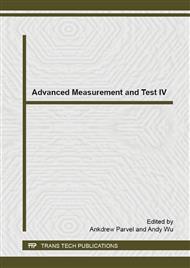[1]
A.F. Devonshire, Theory of barium titanate. – Part I, Philos. Mag. 40 (1949) 1040–1063.
Google Scholar
[2]
M.L. Mulvihill, K. Uchino, L. Zhang, W. -W. Cao, In-situ observation of the domain configurations during the phase transitions in barium titanate, Philos. Mag. B 74 (1996) 25–36.
DOI: 10.1080/01418639608240325
Google Scholar
[3]
D. Hennings, Barium titanate based ceramics materials for dielectric use, Int. J. High Tech. Ceram. 3 (1987) 91–111.
DOI: 10.1016/0267-3762(87)90031-2
Google Scholar
[4]
D. -D. Han, D. -Y. Lu, X. -Y. Sun, Structural evolution and dielectric properties of (Ba1−xNdx)(Ti1−yFey)O3 ceramics, J. Alloys Compd. 576 (2013) 24–29.
DOI: 10.1016/j.jallcom.2013.04.120
Google Scholar
[5]
D. -Y. Lu, Q. -L. Liu, Y. -L. Dong, H. Huang, D. -D. Han, L. Zhang, Temperature calibration of temperature camera on domestic X-ray diffractometer, Modern Sci. Instrum. 2 (2012) 89–93.
Google Scholar
[6]
D. -Y. Lu, W. Cheng, W. -R. Jin, Confirmation of temperature accuracy of low-temperature measurements on domestic X-ray diffractometer, Modern Sci. Instrum. 1 (2014) 153–157.
Google Scholar
[7]
D. -Y. Lu, W. Cheng, P. -Y. Chen, X. -Y. Sun, Temperature correction for ceramic powder X-ray diffraction at a higher temperature, Adv. Mater. Res. 718-720 (2013) 768–772.
DOI: 10.4028/www.scientific.net/amr.718-720.768
Google Scholar
[8]
D. -Y. Lu, Q. -L. Liu, Y. -L. Dong, W. Cheng, Temperature-dependent structure of a high-k (Ba, La)(Ti, Ce)O3 ceramic, Key Eng. Mater. 602–603 (2014) 705–709.
DOI: 10.4028/www.scientific.net/kem.602-603.705
Google Scholar
[9]
R. D. Shannon, Revised effective ionic radii and systematic studies of interatomic distances in halides and chalcogenides, Acta Crystallogr. A 32 (1976) 751–767.
DOI: 10.1107/s0567739476001551
Google Scholar
[10]
E. Mashkina, C. Mccamman, F. Seifert, A Mossbauer study of oxygen vacancy and cation distribution in 6H-BaTi1−xFexO3−x/2, J. Solid State Chem. 177 (2004) 262–267.
DOI: 10.1016/j.jssc.2003.08.008
Google Scholar
[11]
D. Hennings, A. Schnell, G. Simon, Diffuse ferroelectric phase transitions in Ba(Ti1−xZrx)O3 ceramics, J. Am. Ceram. Soc. 65 (1982) 539–544.
DOI: 10.1111/j.1151-2916.1982.tb10778.x
Google Scholar
[12]
D. -Y. Lu, X. -Y. Sun, M. Toda, A novel high-k Y5V, barium titanate ceramics co-doped with lanthanum and cerium, J. Phys. Chem. Solids 68 (2007) 650–664.
DOI: 10.1016/j.jpcs.2007.02.018
Google Scholar
[13]
S. Qiu, W. Li, Y. Liu, G. Liu, Y. Wu, N. Chen, Phase evolution and room temperature ferroelectric and magnetic properties of Fe-doped BaTiO3 ceramics, J. Trans. Nonferrous Met. Soc. 20 (2010) 1911–(1915).
DOI: 10.1016/s1003-6326(09)60394-0
Google Scholar
[14]
F. Ren, S. Ishida, Chemical states, roles and interrelations of additives in BaTiO3 ceramics, J. Ceram. Soc. Jpn. 103 (1995) 759–766.
DOI: 10.2109/jcersj.103.759
Google Scholar
[15]
A. Kirianov, N. Ozaki, H. Ohsato, N. Kohzu, H. Kishi, Studies on the solid solution of Mn in BaTiO3, Jpn. J. Appl. Phys. 40 (2001) 5619–5623.
DOI: 10.1143/jjap.40.5619
Google Scholar
[16]
I. E. Grey, C. Li, L. M. D. Cranswick, R. S. Roth, T. A. Vanderah, Structure analysis of the 6H-Ba(Ti, Fe3+, Fe4+)O3-δ solid solution, J. Solid State Chem. 135 (1998) 312–321.
DOI: 10.1006/jssc.1997.7652
Google Scholar
[17]
F. Lin, D. Jiang, X. Ma, W. Shi, Influence of doping concentration on room-temperature ferromagnetism for Fe-doped BaTiO3 ceramics, J. Magn. Magn. Mater. 320 (2008) 691–694.
DOI: 10.1016/j.jmmm.2007.08.008
Google Scholar
[18]
G. Du, Z. Hu, Q. Han, X. Qin, W. Shi, Effects of niobium donor doping on the phase structures and magnetic properties of Fe-doped BaTiO3 ceramics, J. Alloys Compd. 492 (2010) 79–81.
DOI: 10.1016/j.jallcom.2009.12.031
Google Scholar
[19]
X. K. Wei, Q. H. Zhang, F. Y. Li, C. Q. Jin, R. C. Yu, Structural evolution induced by acceptor doping into BaTiO3 ceramics, J. Alloys Compd. 508 (2010) 486–493.
DOI: 10.1016/j.jallcom.2010.08.099
Google Scholar


